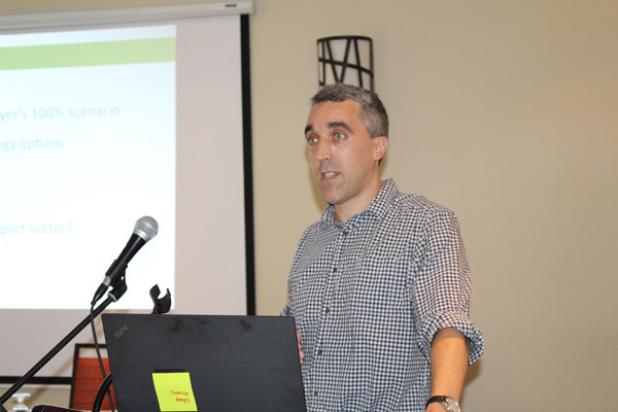
Dr. Thomas Rogers, Lecturer in Renewable Energy at the University of the West Indies, Cave Hill Campus delivering his address.
Wind energy potential
Sat, 09/24/2016 - 12:00am
Onshore wind energy is the cheapest source of renewable energy for the foreseeable future.
That is according to Dr. Thomas Rogers, Lecturer in Renewable Energy at the University of the West Indies, Cave Hill Campus, as he noted that Barbados has good onshore wind potential that should be capitalised on.
Moreover, the university lecturer says to turn technical potential into reality, a more detailed wind resource assessment is needed, as is a wind power electrical integration study to determine how to connect wind turbines to the national grid.
He was speaking yesterday on the topic “A 100 per cent Renewable Future” at the Barbados Town Planning Society (BTPS) seminar at the Courtyard Marriott, under the theme “Planning for Renewable Energy in Barbados”.
Rogers noted that with the continued fall in the prices of solar PV and wind energy and the prospect of increasing oil prices, there is a general realisation among stakeholders in this country that the 100 per cent target is reachable and is possible in today’s market.
“We have the wind and solar integration study that Light and Power did, that was only for 15 megawatts of wind. I’m told that there is another study coming out and there was also a study by the Energy Division, which supports the connection of wind onto the island’s electricity grid, but we need to look at the kind of sizes that we’re talking about, 230 megawatts,” he said.
Rogers’ comments came as he noted that wind energy is a reliable, cheap and proven technology, and he said that while the first wind turbine on the island, erected in the 1980s, was not well received primarily because of the noise factor, the situation should be different going forward as modern wind turbines are quieter, better designed, have a greater power output, and have a longer lifespan. With that in mind, referring to a desktop study he conducted on wind energy potential in Barbados, Rogers said that there are seven zones, mainly in rural Barbados, where the wind turbines can be installed. These include, he said, areas in St. Lucy, St. Peter, Christ Church, St. Philip and St. George particularly agricultural land that is away from domestic properties.
He is suggesting that if erected on such lands, it could be of a benefit to the agricultural sector as well, allowing farmers to generate additional income.
He added that should wind farms be pursued in those zones, it is important that there is public ownership in respect of those ventures to ensure that there is public buy-in. Rogers said that this would help to raise the public’s awareness about wind energy; solves the problems and conflicts that often happen when overseas developers coming in to develop a wind site; and it keeps the revenue earned on the island while strengthening the local economy.
He admitted that there is concern about the impact that wind farms would have on the island’s tourism industry, but contended that the concerns were probably not merited as most visitors to the island are au fait with such technology and are not likely to think that it spoils the landscape. On that note, he said that the turbines could be used as tourist attractions, as have been done in other parts of the world, to afford persons spectacular views around the island. (JRT)
